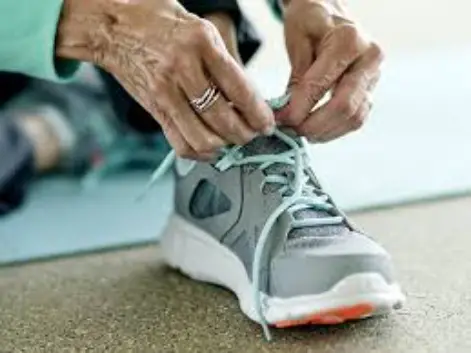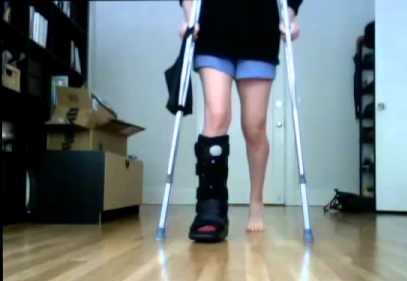While the little or pinky toe might be the cutest toe on the foot, it is also the one subject to more blisters and irritation than the other toes.
And most probably for this very reason, many of our readers often ask the question “how to stop shoes from rubbing my little toe?“.
The good news is that the solution is simple in most cases. But before coming to those solutions let’s know what causes that little toe to hurt.
This in large part is due to the shape of most shoes that must be tight enough to secure the foot while still trying to be comfortable.
For those who have pinky toes that are slightly larger or stick out more than normal, this means exposing them to constant rubbing which leads to blisters.
There are two basic answers. Either you find shoes that allow for enough room without sacrificing comfort or you apply some proven hacks that will work with most shoes.
The result will be that your little toe no longer needs to be sacrificed in the name of comfort.
What follows are 13 proven ways to stop shoes from rubbing against your little toe…

13 Ways To Stop Shoes Rubbing Your Little Toe
1- Get Shoes that Fit Best
This may seem like an obvious tip, but it is one that surprisingly happens more often than it should. The shoes you wear should be snug, but not too tight.
This means finding the right size and width for your feet. Many people often wear a half-size too large or too small which can make all the difference over time.
Keep in mind that your foot may change slightly in size over time. The difference may not seem like much, but it can be enough to cause irritation to your foot and in particular your pinky toes.
All it takes is a little more width in your foot to rub the little toes against the side of the shoe.
Have your feet measured every few years or when you feel a change and get the right size of shoes to that accommodate your toes.
2- Tighten Up the Shoelaces
This is a simple, but effective way to help prevent blisters on your little toe.
Loose lacing may be common, but it works against the little toe because it means that the shoe is not secure against the foot.
The result is that it rubs against the outer side of the foot which includes the little toes.
In addition, your foot may slide forward which presses the toes against the front of the shoe which causes even more issues to occur.
To prevent this, tie your shoelaces properly. That way, they are tight enough to not allow too much room to slide around while being loose enough to let your toes wiggle around.
3- Rub Alcohol and Vaseline
This simple, inexpensive combination can be applied to the inner surface of the shoes around the pinky toe area.
This will help soften the material and provide more lubrication to let your top of toes slide past without causing friction.
Over time, the regular application of rubbing alcohol and Vaseline will cause the area of the shoe to soften and stretch out so you should not have that problem again.
4- Freeze It
This method is so simple that it’s surprising more people have not tried it. Fill a Ziploc bag with water and fit it inside the shoe.
Put the shoe in the freezer overnight and then take it out. The freezing of the water will stretch the inside of the shoe.
If that didn’t do the trick, you can try it again until you get the size you need for better comfort.
5- Shoe Tree
Of course, someone has already developed a product just for this purpose. Shoe stretchers and shoe trees are designed to stretch the interior of the shoe, particularly the toe box, for a better fit.
The downside is that you have to pay for a shoe tree, but they are not that expensive and can come in handy when stretching cheap shoes compared to purchasing custom ones.
In less than $55 FootFitter offers a premium quality professional grade 2-way shoe stretcher that can easily help you to stretch the length and width of your shoes.
Of course, there are many others with half the price available, we do not recommend them as they are cheaply made and are of low quality that does not last for long.

6- Shoe Stretcher Spray
A shoe stretcher spray lets you soften the material around the toe box so that it can be stretched.
You’ll need to spray it as directed and then keep using the product until it reaches the desired size.
7- Stretch with Hair Dryer
If your peep-toe shoes are made from nubuck, suede, or leather, you can stretch the material by using a hairdryer for about five minutes over the toe box.
Every few days, heat up the shoes using the dryer and repeat until you get the right length and width.
Remember that this only works with shoes made from materials designed to stretch, so don’t bother with any shoes made from fabrics.
8- Blister Cushions
You’ve probably seen them in stores for many years, but they really do work when your shoes bite you on your toe.
They are perfect for pinky toes or any specific area of the foot that gets rubbed too often when walking. Simply place the cushion over the area and slide it on your sock.
The cushion acts as a second skin and will absorb the impact and friction while your skin stays protected.
They are well suited when jogging or running as they help reduce impact over that area of the skin.
9- Anti-Blister Balm
This is not grease, but a balm that can be safely applied to the skin.
What it does is greatly reduce the friction against the skin caused by the sides of the shoes moving against the pinky toes.
You can even use it on blisters to help prevent further damage.
10- Moleskin Padding
These rolls are similar in effect to blister cushions in that they are placed over the skin to protect it from friction.
You can wrap your foot in the padding and cover your little toes which should offer ample protection, especially when jogging or running.
You can even apply the moleskin to the interior of the shoes that rub against your little toes. This provides exceptional protection.
11- Gel Toe Cap
If you suffer from blisters that repeat in the same place, then a gel toe cap may be the answer. You can wear it on your pinky toe and it will protect the skin from developing blisters.
A gel toe protector cap is perfect for those who have pinky toes that may be misaligned or larger in size which makes them more vulnerable to blisters.
12- Bigger Toe Box
This is arguably the most common solution is to purchase shoes that have a bigger box for your toes.
A toe box that is too narrow means that your little toe is not going to have enough room to move. Being unable to move will have it rubbing up against the inner lining of the shoe.
Even the sock will not prevent the skin from being irritated and eventually blister because of the lack of room.
The solution is to find shoes that offer a larger box for the big toe. Sometimes you can find reasonably affordable shoes that are wider.
However, you do not want them to be too wide or you’ll experience other issues.
Or, there may be custom shoes that are more expensive but provide enough room to keep the little toe from being pressed against the side.
13- Thick Socks
The thicker the sock, the more cushion it provides. Wearing thick socks helps prevent your pinky toes from rubbing too close against the sides of the shoes.
While it may not always be practical to wear thicker socks, remember that many shoes such as sneakers or tennis shoes have enough flexibility to allow for thicker socks to be present.
Wearing thin & thick socks together is also a great way to stop hurting your pinky toe.
This is an old trick but a good one especially if you are walking or hiking over considerable distances.
Put on a pair of thin socks and then put a thicker pair over the top. The result is that your feet will slide comfortably inside the thinner pair and prevent any blisters or irritations from occurring.
While wearing two pairs of socks is not recommended for everyday use, it can be quite helpful when walking considerable distances.
In the end, there are many things you can do to help prevent your little toes from rubbing against the sides of your shoes.
As a bonus tip, if your feet get quite sweaty when you walk or jog which is causing the pinky toes to stick to the sides, try using an antiperspirant.
This simple trick can keep your feet dry and reduce the chance of blistering.
Remember to try the simpler tips first before spending more money to change out your shoes.
When your little toe rubs against the shoe, you may find that products around the home or simply wearing thicker socks will do the trick.
Only when you have exhausted such efforts should you pay for products that may help.




